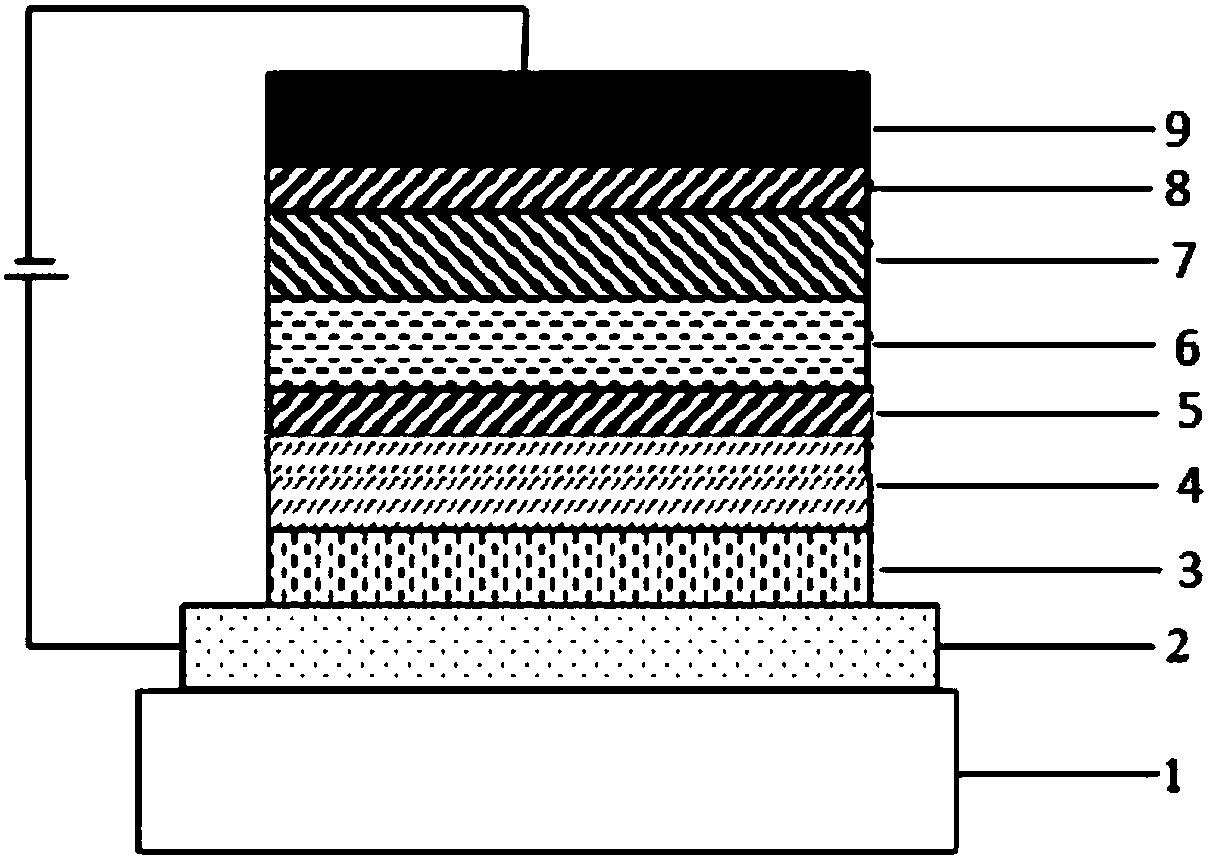Organic compound with fluorene as main body and organic electroluminescent device
An organic compound and host technology, applied in the field of organic compounds and organic electroluminescent devices, can solve problems such as disparity, avoid aggregation, reduce efficiency roll-off, and improve hole injection/transport performance.
- Summary
- Abstract
- Description
- Claims
- Application Information
AI Technical Summary
Problems solved by technology
Method used
Image
Examples
Embodiment 1
[0141] Embodiment 1: the synthesis of organic compound (6):
[0142] synthetic route:
[0143]
[0144] In a 250ml three-neck flask, under the protection of nitrogen, add 0.01mol 9,9'-diphenyl-3-bromofluorene, 0.012mol intermediate A1, 150ml toluene and stir to mix, then add 0.03mol sodium tert-butoxide, 5× 10 -5 molPd 2 (dba) 3 , 5×10 - 5 mol of tri-tert-butylphosphine, heated to 105°C, reflux reaction for 24 hours, sampling plate, showing no bromide remaining, the reaction was complete; naturally cooled to room temperature (15-30°C), filtered, and the filtrate was rotated under reduced pressure ( -0.09MPa, 85°C), passed through a neutral silica gel column to obtain the target product, with an HPLC purity of 99.2% and a yield of 74.6%;
[0145] Elemental analysis structure (molecular formula C 46 h 33 NO): theoretical value C, 89.73; H, 5.40; N, 2.27; 0, 2.60; found value: C, 89.72;
[0146] HPLC-MS: The molecular weight of the material is 615.26, and the measured...
Embodiment 2
[0147] Embodiment 2: the synthesis of organic compound (7):
[0148] synthetic route:
[0149]
[0150] In a 250ml three-neck flask, under nitrogen protection, add 0.01mol 9,9'-diphenyl-3-bromofluorene, 0.012mol intermediate A2, 150ml toluene and stir to mix, then add 0.03mol sodium tert-butoxide, 5× 10 -5 molPd 2 (dba) 3 , 5×10 - 5 mol of tri-tert-butylphosphine, heated to 105°C, refluxed for 24 hours, sampling plate, showed no remaining bromide, the reaction was complete; naturally cooled to room temperature, filtered, and the filtrate was rotary evaporated under reduced pressure (-0.09MPa, 85°C ), through a neutral silica gel column, to obtain the target product, HPLC purity 99.3%, yield 75.5%;
[0151] Elemental analysis structure (molecular formula C 46 h 33 NO): Theoretical C, 89.73; H, 5.40; N, 2.27; O, 2.60; Tested: C, 89.71; H, 5.42; N, 2.26;
[0152] HPLC-MS: The molecular weight of the material is 615.26, and the measured molecular weight is 615.49.
Embodiment 3
[0153] Embodiment 3: the synthesis of organic compound (11):
[0154] synthetic route:
[0155]
[0156] In a 250ml three-neck flask, under nitrogen protection, add 0.01mol 9,9'-diphenyl-3-bromofluorene, 0.012mol intermediate A3, 150ml toluene and stir to mix, then add 0.03mol sodium tert-butoxide, 5× 10 -5 molPd 2 (dba) 3 , 5×10 - 5 mol of tri-tert-butylphosphine, heated to 105°C, refluxed for 24 hours, sampling plate, showed no remaining bromide, the reaction was complete; naturally cooled to room temperature, filtered, and the filtrate was rotary evaporated under reduced pressure (-0.09MPa, 85°C ), through a neutral silica gel column, to obtain the target product, HPLC purity 99.1%, yield 75.1%;
[0157] Elemental analysis structure (molecular formula C 46 h 33 NO): Theoretical C, 89.73; H, 5.40; N, 2.27; O, 2.60; Tested: C, 89.71;
[0158] HPLC-MS: The molecular weight of the material is 615.26, and the measured molecular weight is 615.52.
PUM
| Property | Measurement | Unit |
|---|---|---|
| Thickness | aaaaa | aaaaa |
Abstract
Description
Claims
Application Information
 Login to View More
Login to View More - R&D
- Intellectual Property
- Life Sciences
- Materials
- Tech Scout
- Unparalleled Data Quality
- Higher Quality Content
- 60% Fewer Hallucinations
Browse by: Latest US Patents, China's latest patents, Technical Efficacy Thesaurus, Application Domain, Technology Topic, Popular Technical Reports.
© 2025 PatSnap. All rights reserved.Legal|Privacy policy|Modern Slavery Act Transparency Statement|Sitemap|About US| Contact US: help@patsnap.com



